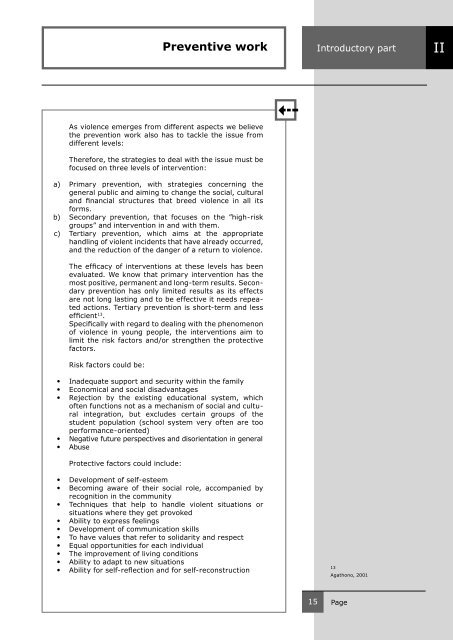Who are you? - Emergency Brake
Who are you? - Emergency Brake
Who are you? - Emergency Brake
Create successful ePaper yourself
Turn your PDF publications into a flip-book with our unique Google optimized e-Paper software.
a)<br />
b)<br />
c)<br />
•<br />
•<br />
•<br />
•<br />
•<br />
•<br />
•<br />
•<br />
•<br />
•<br />
•<br />
•<br />
•<br />
•<br />
•<br />
As violence emerges from different aspects we believe<br />
the prevention work also has to tackle the issue from<br />
different levels:<br />
Therefore, the strategies to deal with the issue must be<br />
focused on three levels of intervention:<br />
Primary prevention, with strategies concerning the<br />
general public and aiming to change the social, cultural<br />
and financial structures that breed violence in all its<br />
forms.<br />
Secondary prevention, that focuses on the ”high-risk<br />
groups” and intervention in and with them.<br />
Tertiary prevention, which aims at the appropriate<br />
handling of violent incidents that have already occurred,<br />
and the reduction of the danger of a return to violence.<br />
The efficacy of interventions at these levels has been<br />
evaluated. We know that primary intervention has the<br />
most positive, permanent and long-term results. Secondary<br />
prevention has only limited results as its effects<br />
<strong>are</strong> not long lasting and to be effective it needs repeated<br />
actions. Tertiary prevention is short-term and less<br />
efficient 13 .<br />
Specifically with regard to dealing with the phenomenon<br />
of violence in <strong>you</strong>ng people, the interventions aim to<br />
limit the risk factors and/or strengthen the protective<br />
factors.<br />
Risk factors could be:<br />
Inadequate support and security within the family<br />
Economical and social disadvantages<br />
Rejection by the existing educational system, which<br />
often functions not as a mechanism of social and cultural<br />
integration, but excludes certain groups of the<br />
student population (school system very often <strong>are</strong> too<br />
performance-oriented)<br />
Negative future perspectives and disorientation in general<br />
Abuse<br />
Protective factors could include:<br />
Preventive work Introductory part II<br />
Development of self-esteem<br />
Becoming aw<strong>are</strong> of their social role, accompanied by<br />
recognition in the community<br />
Techniques that help to handle violent situations or<br />
situations where they get provoked<br />
Ability to express feelings<br />
Development of communication skills<br />
To have values that refer to solidarity and respect<br />
Equal opportunities for each individual<br />
The improvement of living conditions<br />
Ability to adapt to new situations<br />
Ability for self-reflection and for self-reconstruction<br />
15<br />
13<br />
Agathono, 2001<br />
Page


